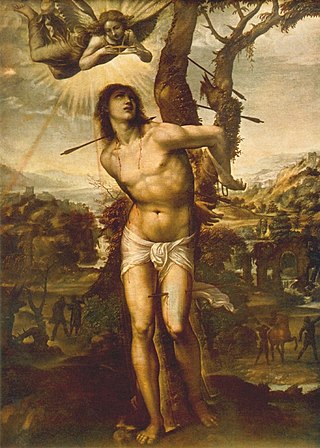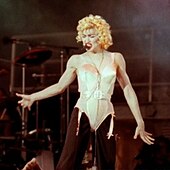
A concept album is an album whose tracks hold a larger purpose or meaning collectively than they do individually. This is typically achieved through a single central narrative or theme, which can be instrumental, compositional, or lyrical. Sometimes the term is applied to albums considered to be of "uniform excellence" rather than an LP with an explicit musical or lyrical motif. There is no consensus among music critics as to the specific criteria for what a "concept album" is.

Michio Kaku is an American theoretical physicist, activist, futurologist, and popular-science writer. He is a professor of theoretical physics in the City College of New York and CUNY Graduate Center. Kaku is the author of several books about physics and related topics and has made frequent appearances on radio, television, and film. He is also a regular contributor to his own blog, as well as other popular media outlets. For his efforts to bridge science and science fiction, he is a 2021 Sir Arthur Clarke Lifetime Achievement Awardee.

American singer and actress Madonna is an ally recognized as a gay icon. She was introduced, while still a teenager, by her dance instructor, Christopher Flynn, an openly gay man who mentored her. Since then, Madonna has always acknowledged the importance of the community for her life and career, declaring that she "wouldn't have a career if it weren't for the gay community".

Cuban Spanish is the variety of the Spanish language as it is spoken in Cuba. As a Caribbean variety of Spanish, Cuban Spanish shares a number of features with nearby varieties, including coda weakening and neutralization, non-inversion of Wh-questions, and a lower rate of dropping of subject pronouns compared to other Spanish varieties. As a variety spoken in Latin America, it has seseo and lacks the vosotros pronoun.

A Madonna wannabe, or Madonnabe, is a person who dresses or acts like American singer Madonna. When she emerged into stardom in the mid-1980s, an unusually high number of women, particularly young women and girls, began to dress and do their hair and makeup in the style that Madonna displayed in public. The term was popularized by writer John Skow in a May 1985 Time cover story on the singer. Numerous sociologists and other academics commented on the Madonna influence in her wannabes.

A gay icon is a public figure who is regarded as a cultural icon by members of the LGBT community. Such figures usually have a devoted LGBT fanbase and act as allies to the LGBT community, often through their work, or they have been "openly appreciative of their gay fanbase". Many gay icons also have a camp aesthetic style, which is part of their appeal to LGBT individuals.

Madonna studies is the study of the work and life of American singer-songwriter Madonna using an interdisciplinary approach incorporating cultural studies and media studies. In a general sense, it could refer to any academic studies devoted to her. After Madonna's debut in 1983, the discipline did not take long to start up and the field appeared in the mid-1980s, achieving its peak in the next decade. Educator David Buckingham deemed her presence in academic circles as "a meteoric rise to academic canonisation". The rhetoric academic view of that time, majority in the sense of postmodernism, generally considered her as "the most significant artist of the late twentieth century", thus she was understood variously and as a vehicle to open up issues. In the 21st century, academic studies about Madonna have remained and continued in many aspects. At the height of its developments, authors of these academic writings were sometimes called "Madonna scholars" or "Madonnologists", and both E. Ann Kaplan and John Fiske were classified as precursors.

Matthew Rettenmund is a Michigan-born editor, founder of Popstar! magazine and blog Boyculture.com, as well author of different books, including 1995 works, Encyclopedia Madonnica which debuted with solid reviews and sales, and the novel Boy Culture, which was later adapted into a movie in 2006 and in a spin-off web series in the 2020s with rave reviews.
Popular culture is generally recognized by members of a society as a set of practices, beliefs, artistic output and objects that are dominant or prevalent in a society at a given point in time. Popular culture also encompasses the activities and feelings produced as a result of interaction with these dominant objects. The primary driving forces behind popular culture, especially when speaking of Western popular cultures, are the media, mass appeal, marketing and capitalism; and it is produced by what philosopher Theodor Adorno refers to as the "culture industry".

This is a list containing the different written works about Madonna, including biographies and other literary forms. Many authors have written more than one book about Madonna and these have been published in multiple languages other than English, including German, French, Dutch, Spanish and Italian. The releases have sometimes become bestsellers and have faced varied reception from critics and academics. The staff of Xtra Magazine commented that "she has inspired a mini publishing industry all her own". Maura Johnston said that "the appetite for books on Madonna is large, and the variety of approaches writers, editors, and photographers have taken to craft their portraits is a testament to how her career has both inspired and provoked". On the report of Eric Weisbard "only Madonna books proliferated" compared to her other contemporary fellows from the 1980s. Evelyn Briceno from La Tercera described her as a character worthy of biographies, photo books and various analyses.

American singer-songwriter Madonna has had a social-cultural impact on the world through her recordings, attitude, clothing and lifestyle since her early career in the 1980s. Madonna has built a legacy that goes beyond music and has been studied by sociologists, historians and other social scientists. This contributed to the rise of the Madonna studies, an academic and critical response dedicated to her work and persona for which Madonna's semiotic and image was diversified in a wide-ranging of theoretical stripe from feminism to queer studies among others.
Mary Cross is an American professor, editor, writer and biographer. She has written several books including biographies of figures such as Henry James and Madonna. Madonna biography was reviewed by New York Post as "fast, accurate and concise", became widely quoted and translated. Cross is professor emerita of English at Fairleigh Dickinson University, and she has taught at the City University of New York and University of Delaware. Cross has a PhD from Rutgers University and a BA from the University of Michigan. As an editor, she publisher various works, including 100 People Who Changed 20th-Century America.

Madonna is a 1989 Hindi-language platinum-selling pop album by Indipop star Alisha Chinai.

Madonna fandom refers to the fan community of American singer-songwriter Madonna. She attained cult status amongst different audiences according to professor Sheila Jeffreys. Unlike other fandoms, her fan base does not have an official moniker, although "Madonna wannabe" became a popular media label to talk about her fans over years. The fanaticism surrounding the singer, and also called Madonnamania initiated no later than 1985. She produced consecutive successful singles in various major music markets, established numerous international records and impacted the fashion industry. Thousands of her female fans were dressing like Madonna around the world and the term "Madonna wannabe" was born. Author and scholar Lisa Lewis believes she is "one of the first women to attract the kind of devotion of young female fans normally associated with male rock stars".

American singer-songwriter Madonna has been considered a fashion and style icon by fashion journalism and other sectors. Fashion critics, designers and scholars have examined her influence in fashion from different stages, shaping views on her public image and cultural significance. Her connection with the community was once labeled a symbiotic relationship, while her industry ventures include owning fashion brands and appearing at events such as the Met Gala.

American singer-songwriter Madonna has been considered a sexual icon and defined by an author, as the leading sex symbol of the postmodern era. Many have considered Madonna's sexuality as one of the focal points of her career. The Oxford Dictionary of English (2010) even credited her image as a sex symbol as a source of her international stardom. Her sexual displays have drawn numerous analysis by scholars, sexologists, feminists, and other authors. Due to her constant usage of explicit sexual content, Madonna faced censorship by MTV for her videos, as well as by other entities for her stage performances, and other projects in her early career.

American singer-songwriter Madonna is recognized by many generations as a feminist icon. Throughout best part of her career, Madonna's forays into feminism, womanhood and media representation of women have sparked discussions among numerous feminist scholars and commentators worldwide. She has also been noted for her advocacy of women's rights.

American singer-songwriter and actress Madonna has incorporated in her works abundant references of religious themes of different religions and spiritual practices, including Christianity, Hinduism, Buddhism, Sufism, and Kabbalah. Several theologians, sociologists of religion and other scholars have reviewed her, while professor Arthur Asa Berger stated that she has raised many questions about religion. Due to her prominent use, an academic described her as "perhaps the first artist of our time to routinely and successfully employ images from many spiritual cultures and multiple religious traditions".

American entertainer Madonna debuted in media in the early 1980s. Once called a media icon, popular and critical explorations of her media figure spanned decades, and included areas such as media studies and communication studies, as well her celebrity encompassed a wide range spectrum of themes, from fame to popularity, declive and longevity. Besides this, reviews often transcended Madonna's own career as many authors noted an impact on others and in celebrity culture; even decades after her debut. Her early media dominance in various formats, led to various authors referred to her variously, including "Queen of MTV" and more retrospectively as "Queen of Media". Madonna also influenced a number of editors and authors.



















